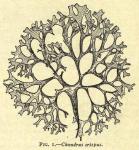 The dried plant Chon'drus cris'pus Lyngbye. (Fam. Gigartinaceae.)
The dried plant Chon'drus cris'pus Lyngbye. (Fam. Gigartinaceae.)
BOTANICAL CHARACTERISTICS.—Thallus fleshy, cartilaginous, compressed, dividing into short, moniliform filaments. Antheridia or oogonia in superficial spots. Chondrus crispus has four vessels or capsules imbedded in the frond. Gigartina mamillosa (Chondrus mamillosa) has an oval one raised upon a short stalk, and its frond is slightly channeled toward the base.
SOURCE.—These plants inhabit the rocks on the American and European shores of the Atlantic Ocean. In the spring they are collected on the coast of New England and Ireland, the Massachusetts coast yielding about 15,000 barrels annually.
DESCRIPTION OF DRUG.—Yellowish or white, horny, translucent; many times forked; when softened in water, cartilaginous; shape of the segments varying from wedge-shaped to linear; at the apex emarginate or 2-lobed. It has a slight seaweed-like odor, and a mucilaginous, somewhat saline, taste.
TEST.—When one part of Chondrus is boiled for about ten minutes with thirty parts of water replacing water lost by evaporation, the solution should form a thick jelly upon cooling.
When softened in cold water chondrus should become gelatinous and transparent the thallus remaining nearly smooth and uniform and not swollen except at the tips.
A solution made by boiling 0.3 Gm. in 100 mils of water and filtering gives no precipitate on the addition of tannic acid T.S. (gelatin), and does not give a blue color when cold upon addition of iodine T.S. (starch).
CONSTITUENTS.—The principal constituent (90 per cent.) is mucilage, which is precipitated by lead acetate; traces of iodine and bromine have also been detected. There seems to be no starch present, but the cell-walls acquire a dark blue color in contact with iodine (Flückiger). Literature rather contradictory as to the nature of its various constituents.
ACTION AND USES.—Demulcent and slightly nutritious. A dietetic is specially prepared from the powder, made in the form of jelly with water. Dose: 6 dr. (24 mils) in decoction.

